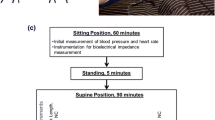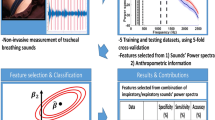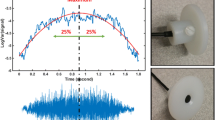Abstract
Obstructive Sleep apnea can be caused by fluid shift from the legs to the neck that narrows the upper airway (UA) and contributes to changes in tracheal sound. Tracheal sound is generated from the turbulent airflow in the pharynx and respiratory airways and it has recently been used to estimate increases in neck fluid volume (NFV). However, tracheal sound is also highly variable among people, especially across the sexes. In this paper, a novel method is proposed to select tracheal sound features towards estimating NFV in men and women separately. To validate this method, it was applied to the tracheal sound data of 28 healthy individuals. Our proposed feature selection algorithm is based on sparse representations and incorporates NFV to maximize the relevance of selected features. This feature selection eliminates the dependence of the previous methods on calibrating the model for every individual. Two models, regression and Kalman filters, are then used to estimate NFV from selected features. Kalman filter obtains the highest performance, estimating NFV with more than 90% accuracy in both men and women. This algorithm can be used to develop non-invasive acoustic technologies to investigate the effects of fluid on UA anatomy in general applications. These results could be used to develop convenient devices to monitor the neck edema and its contribution to sleep apnea severity in fluid retaining patients such as heart or renal failure.



Similar content being viewed by others
Abbreviations
- AHI:
-
Apnea-hypopnea index
- ANOVA:
-
Analysis of variance
- BMI:
-
Body mass index, kg/m2
- MFCC:
-
Mel-frequency cepstral coefficients
- NC:
-
Neck circumference
- NFV:
-
Neck fluid volume
- OSA:
-
Obstructive sleep apnea
- RPDE:
-
Recurrence period density entropy
- UA:
-
Upper airway
References
Arens R, Marcus CL (2004) Pathophysiology of upper airway obstruction: a developmental perspective. Sleep 27:997–1019
Bracco D, Thiébaud D, Chioléro RL, Landry M, Burckhardt P, Schutz Y (1996) Segmental body composition assessed by bioelectrical impedance analysis and DEXA in humans. J Appl Physiol 81:2580–2587
Carré R (2009) Dynamic properties of an acoustic tube: prediction of vowel systems. Speech Commun 51:26–41
Chiu K-L, Ryan CM, Shiota S, Ruttanaumpawan P, Arzt M, Haight JS et al (2006) Fluid shift by lower body positive pressure increases pharyngeal resistance in healthy subjects. Am J Respir Crit Care Med 174:1378–1383
Darch J, Milner B, Vaseghi S (2008) Analysis and prediction of acoustic speech features from mel-frequency cepstral coefficients in distributed speech recognition architectures. J Acoust Soc Am 124:3989–4000
Draper NR, Smith H (2014) Applied regression analysis. Wiley, Hoboken
Fleetham J (1992) Upper airway imaging in relation to obstructive sleep apnea. Clin Chest Med 13:399–416
Flemons WW (2002) Obstructive sleep apnea. N Engl J Med 347:498–504
Fredberg JJ, Wohl M, Glass GM, Dorkin HL (1980) Airway area by acoustic reflections measured at the mouth. J Appl Physiol 48:749–758
Gabriel JM, White L, Kasai T, Bradley D, Yadollahi A (2013) Effects of normal saline infusion on inducing sleep apnea in healthy individuals, in D30. Sleep apnea pathogenesis: mechanical and neural mechanisms. Am Thoracic Soc, A5477–A5477
Kasai T, Bradley TD (2011) Obstructive sleep apnea and heart failure: pathophysiologic and therapeutic implications. J Am Coll Cardiol 57:119–127
Kasai T, Motwani SS, Yumino D, Mak S, Newton GE, Bradley TD (2012) Differing relationship of nocturnal fluid shifts to sleep apnea in men and women with heart failure. Circ Heart Fail 5:467–474
Kasai T, Bradley TD, Friedman O, Logan AG (2014) Effect of intensified diuretic therapy on overnight rostral fluid shift and obstructive sleep apnoea in patients with uncontrolled hypertension. J Hypertens 32:673–680
Ling CH, de Craen AJ, Slagboom PE, Gunn DA, Stokkel MP, Westendorp RG et al (2011) Accuracy of direct segmental multi-frequency bioimpedance analysis in the assessment of total body and segmental body composition in middle-aged adult population. Clin Nutr 30:610–615
Lyons OD, Chan CT, Yadollahi A, Bradley TD (2015) Effect of ultrafiltration on sleep apnea and sleep structure in patients with end-stage renal disease. Am J Respir Crit Care Med 191:1287–1294
Mendelson M, Lyons OD, Yadollahi A, Inami T, Oh P, Bradley TD (2016) Effects of exercise training on sleep apnoea in patients with coronary artery disease: a randomised trial. Eur Respir J ERJ-01897-2015
Redolfi S, Arnulf I, Pottier M, Bradley TD, Similowski T (2011) Effects of venous compression of the legs on overnight rostral fluid shift and obstructive sleep apnea. Respir Physiol Neurobiol 175:390–393
Reichert S, Gass R, Brandt C, Andrès E (2008) Analysis of respiratory sounds: state of the art. Clin Med Insights Circ Respir Pulm Med 2:45
Remmers J, DeGroot W, Sauerland E, Anch A (1978) Pathogenesis of upper airway occlusion during sleep. J Appl Physiol 44:931–938
Robb M, Yates J, Morgan E (1997) Vocal tract resonance characteristics of adults with obstructive sleep apnea. Acta Otolaryngol 117:760–763
Seely AJ, Macklem PT (2004) Complex systems and the technology of variability analysis. Crit Care 8:1
Segal Y, Malhotra A, Pillar G (2008) Upper airway length may be associated with the severity of obstructive sleep apnea syndrome. Sleep Breath 12:311–316
Shiota S, Ryan CM, Chiu K-L, Ruttanaumpawan P, Haight J, Arzt M et al (2007) Alterations in upper airway cross-sectional area in response to lower body positive pressure in healthy subjects. Thorax 62:868–872
Shokrollahi M, Krishnan S (2015) A review of sleep disorder diagnosis by electromyogram signal analysis. Crit Rev™ Biomed Eng 43
Shokrollahi M, Krishnan S (2015) Non-stationary signal feature characterization using adaptive dictionaries and non-negative matrix factorization. Signal Image Video Process, 1–8
Strollo PJ Jr, Rogers RM (1996) Obstructive sleep apnea. N Engl J Med 334:99–104
White LH, Bradley TD (2013) Role of nocturnal rostral fluid shift in the pathogenesis of obstructive and central sleep apnoea. J physiol 591:1179–1193
White LH, Lyons OD, Yadollahi A, Ryan CM, Bradley TD (2015) Effect of below-the-knee compression stockings on severity of obstructive sleep apnea. Sleep Med 16(2):258–264
Yadollahi A, Moussavi ZM (2006) A robust method for estimating respiratory flow using tracheal sounds entropy. IEEE Trans Biomed Eng 53(4):662–668
Yadollahi A, Giannouli E, Moussavi Z (2010) Sleep apnea monitoring and diagnosis based on pulse oximetery and tracheal sound signals. Med Biol Eng Comput 48(11):1087–1097
Yadollahi A, Rudzicz F, Mahallati S, Coimbra M, Bradley T (2014) Acoustic estimation of neck fluid volume. Ann Biomed Eng 42:2132–2142
Yadollahi A, Gabriel JM, White LH, Taranto Montemurro L, Kasai T, Bradley TD (2014) A randomized, double crossover study to investigate the influence of saline infusion on sleep apnea severity in men. Sleep 37:1699–1705
Yadollahi A, Singh B, Bradley TD (2015) Investigating the dynamics of supine fluid redistribution within multiple body segments between men and women. Ann Biomed Eng 43:2131–2142
Yadollahi A, Vena D, Lyons O, Bradley T (2016) Relationship of fluid accumulation in the neck to sleep structure in men during daytime sleep. J clin sleep med JCSM
Acknowledgements
This project was supported by Canadian Institutes of Health Research (CIHR) operating grant MOP-82731, and the CIHR Training Grant in Sleep and Biological Rhythms. M. Shokrollahi is funded through Mitacs Elevate and AGE-WELL fellowships. Frank Rudzicz’s contribution to this work is funded by an NSERC Discovery grant (RGPIN 435874), a Young Investigator award by the Alzheimer Society of Canada, and a grant from the AGE-WELL National Centers of Excellence (WP2.3). D. Vena by Mitacs Ph.D. fellowship. T.D. Bradley is funded by the Clifford Nordal Chair in Sleep Apnea and Rehabilitation Research and the Godfrey S. Pettit Chair in Respiratory Medicine.
Author information
Authors and Affiliations
Corresponding author
Rights and permissions
About this article
Cite this article
Shokrollahi, M., Rudzicz, F., Vena, D. et al. A novel approach for acoustic estimation of neck fluid volume between men and women. Med Biol Eng Comput 56, 113–123 (2018). https://doi.org/10.1007/s11517-017-1675-1
Received:
Accepted:
Published:
Issue Date:
DOI: https://doi.org/10.1007/s11517-017-1675-1




